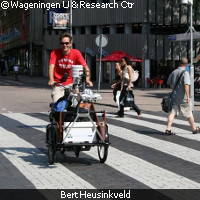European researchers study urban heat islands on bikes, from the air and from space
This summer, research teams studied the climate-change-related phenomenon of 'urban heat islands' using bicycle-mounted equipment in the Netherlands and ground-based and airborne technologies over Greece. Both investigations are part of a wider effort to understand, mitigate and adapt to rising temperatures in European cities. Heat waves strike cities hardest because they are densely laid out and green space tends to be limited. Higher daytime temperatures and reduced night-time cooling in cities compared to the surrounding area are collectively referred to as the 'urban heat island' effect. The elderly are particularly hard hit; during heat waves, urban mortality rates are well above average. This August, researchers from Wageningen University in the Netherlands loaded two cargo bicycles with measurement equipment and rode them through Rotterdam and Arnhem, participants in the EU Future Cities project. The bikes were able to manoeuvre easily through narrow city streets while the solar-powered equipment remained horizontal (and stable enough to operate). Data was collected at various points during a 24-hour period. The sensors measured temperature, humidity, wind direction and wind speed, as well as the amount of sunlight and heat-radiation exchange. Measurements were taken once per second, and at fixed intervals in the route photographs were taken from 50 cm above the ground (roughly wheel-hub-high) with a fish-eye lens pointed upwards. This helped to establish how much of the ground was overshadowed by either buildings or greenery. The findings showed a remarkable 7°C difference between Rotterdam city and the countryside beyond the airport during the night. Remarkably, while the city was 2°C hotter than the airport during the day, one of the city's parks (De Twee Heuvelen) was 2.4°C cooler than the airport in the afternoon - a variance of 4.4°C in the urban area. The 'felt', or perceived, air temperature was 6°C higher in the city than at the airport. The results of the Arnhem study were similar. The Future Cities researchers will determine the specific factors that affect local temperature differences within cities. Their data will ultimately be used to inform design rules and tools that urban developers can use to mitigate the effects of climate change on heat stress in cities. Meanwhile, Athens was studied overhead using satellites and two aircraft with specialised measurement equipment, while a group of thermal remote-sensing and urban-climate experts took ground-based measurements in and around the city. The Spanish plane used an instrument called a 'hyperspectral imaging spectrometer', which is sensitive to both visible and thermal-infrared wavelengths, while the Greek plane measured air-turbulence, temperature, pressure and relative humidity. Several satellites, including two ESA satellites, provided further relevant data. The Spanish and Greek scientists on the ground took atmospheric and radiometric measurements. The team is now analysing the masses of data collected. They will repeat the exercise later this year and next year. 'The analysis of the dataset will allow us to better understand how urban heat islands vary in the city of Athens,' explained Kostas Kourtidis of Democritus University of Thrace, who was in charge of the ground measurements. 'This should help us come one step closer to the operational forecasting of urban temperatures at high spatial resolution.' The researchers hope the final results will help them to improve urban heat island assessments, develop urban heat-wave forecasting techniques, refine alert systems and improve urban planning by pinpointing metropolitan areas where the effect is less intense. Future Cities is funded by the EU's Interreg IVB North-West Europe (NWE) programme, which co-finances projects that tackle common challenges through transnational cooperation. Future Cities aims to make the cities of northwest Europe fit to cope with predicted climate-change impacts (e.g. the intensification of urban heat islands and flash flooding) by encouraging the proactive transformation of urban structures. Participants include the municipalities of Tiel, Arnhem and Nijmegen in the Netherlands, Hastings in the UK, West Flanders in Belgium, the German water boards and the French Rouen-Seine Aménagement.
Countries
Greece, Netherlands



